Government Health Insurance
Table 18-6 shows the breakdown of health insurance coverage across the U.S. population in 2013. A majority of Americans, nearly 170 million people, received health insurance through their employers. The majority of those who didn’t have private insurance were covered by two government programs, Medicare and Medicaid. (The numbers don’t add up because some people have more than one form of coverage. For example, many recipients of Medicare also have supplemental coverage either through Medicaid or private policies.)
|
Covered by private health insurance |
201.1 |
|---|---|
|
Employment- |
169.0 |
|
Direct purchase |
34.5 |
|
Covered by government |
107.6 |
|
Medicaid |
54.1 |
|
Medicare |
49.0 |
|
Military health care |
14.1 |
|
Not covered |
42.0 |
|
Source: U.S. Census Bureau. |
|
Medicare, financed by payroll taxes, is available to all Americans 65 and older, regardless of their income and wealth. It began in 1966 as a program to cover the cost of hospitalization but has since been expanded to cover a number of other medical expenses. You can get an idea of how much difference Medicare makes to the finances of elderly Americans by comparing the median income per person of Americans 65 and older—

At the beginning of 2006, there was a major expansion of Medicare to cover the cost of prescription drugs. At the time Medicare was created, drugs played a relatively minor role in medicine and were rarely a major expense for patients. Today, however, many health problems, especially among the elderly, are treated with expensive drugs that must be taken for years on end, placing severe strains on some people’s finances. As a result, a new Medicare program, known as Part D, was created to help pay these expenses.
Unlike Medicare, Medicaid is a means-
Nearly 14 million Americans receive health insurance as a consequence of military service. Unlike Medicare and Medicaid, which pay medical bills but don’t deliver health care directly, the Veterans Health Administration, which has more than 8 million clients, runs hospitals and clinics around the country.
The U.S. health care system, then, offers a mix of private insurance, mainly from employers, and public insurance of various forms. Most Americans have health insurance either from private insurance companies or through various forms of government insurance. Yet in 2012, before the implementation of the Affordable Care Act, almost 48 million, or 15.4% of the population, had no health insurance at all. What accounted for the high number of uninsured? And why was it such a severe problem that it spurred the passage of the Affordable Care Act?